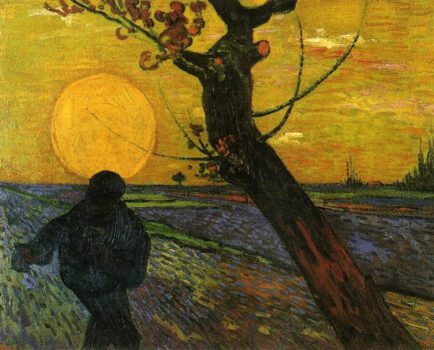Meaning of “The Sower” Painting by Vincent van Gogh
Vincent van Gogh’s The Sower is more than a painting. It is a poetic reflection of his psyche, a theological metaphor, and a tribute to labor, nature, and the human condition. Painted in 1888, at the height of his creative powers during his time in Arles, The Sower stands as one of his most evocative works. Through a single figure, a man sowing seeds in a golden field under a surreal sky, Van Gogh articulates themes of hope, renewal, death, and rebirth. The painting vibrates with emotional intensity and spiritual symbolism.
In this comprehensive analysis, we’ll explore who Van Gogh was when he created this masterpiece, how he painted it, the artistic context and style of the work, the narrative within the painting, and the deeper meanings and symbols embedded in the image. We will also discover where the painting resides today and why it remains one of the most profound statements in modern art history.
Who Painted The Sower and When?
Vincent van Gogh (1853–1890) was a Dutch Post-Impressionist painter whose work shaped the course of modern art. Van Gogh is known for his emotionally charged and vibrantly colored paintings. Though largely unrecognized during his lifetime, his work would later influence Expressionism, Fauvism, and early abstraction.
Van Gogh painted The Sower in June of 1888 while living in Arles, in the south of France. This was a prolific period for him, he completed over 200 paintings in just 15 months. During this time, he was deeply influenced by Japanese woodblock prints, the bright Provençal sunlight, and the everyday lives of rural people. All these elements converge in The Sower, which is actually one of several iterations he painted on this theme.
How The Sower Was Painted
The Sower that most people recognize today is the oil on canvas painting measuring approximately 64 cm × 80.5 cm (25.2 in × 31.7 in). Van Gogh painted this version in June 1888. But the theme of sowing had long fascinated him. In fact, he had made earlier studies and paintings based on works by Jean-François Millet, a French Realist painter whose romantic depictions of peasants deeply influenced Van Gogh.
Van Gogh’s technique in The Sower is immediately recognizable: thick impasto brushwork, dynamic line, and bold, exaggerated color. The canvas is alive with movement, the strokes swirl and pulse, especially in the sun and the sky. His brush dances across the field, suggesting the rustling of wheat, the warm wind, the turn of the seasons.
He often painted directly from nature, en plein air, but with The Sower, he combined observation with imagination. The sky is an exaggerated shade of violet and blue; the sun is an orb of molten gold. This is not realism, it is emotional truth.
What Is The Sower All About?
At the most basic level, the painting shows a man sowing seeds in a field. The viewer sees him in mid-stride, casting seeds with an elegant, sweeping gesture. A blazing sun dominates the upper left of the canvas. In the distance, a tree looms, bisecting the canvas. A freshly plowed field stretches beneath him.
But beneath this simple act of labor lies a universe of meaning.
Van Gogh saw the figure of the sower not just as a laborer but as a symbol of life’s cyclical nature. The act of sowing, throwing seeds to the earth, was, to him, akin to planting hope, faith, and resurrection. The figure is not passive; he is a creative force. He plants the future.
Symbolism and Meaning in The Sower
Let’s delve deeper into the rich layers of symbolism within The Sower. Van Gogh was a deeply spiritual man. Though he had broken from organized religion, he often infused his art with Christian themes, reinterpreted through his own existential lens.
1. The Sun as Divine Illumination
The large, glowing sun is not a simple source of light; it is the all-seeing eye, the divine spark, the sustainer of life. It dominates the sky, casting an unearthly glow on everything. Van Gogh revered the sun as a symbol of energy and presence.
The sun here is not gentle; it is ferocious, overwhelming, transformative. It burns, but it also blesses.
2. The Tree and Division of Space
The large tree in the center of the painting bisects the canvas, creating a division between the act of sowing and the waiting land. It might represent the boundary between the earthly and the spiritual, or the past and the future.
3. Color Symbolism
Van Gogh’s colors are never merely decorative, they are emotive. The deep blues and purples in the sky contrast with the yellow sun and golden field. Blue often represented the infinite or the divine in Van Gogh’s palette, while yellow symbolized light, life, and love.
The field’s vibrant tones create a sense of heat and fertility. This is no ordinary landscape, it’s alive with meaning, echoing with the cycles of nature.
5. The Figure’s Solitude
The sower is alone. There are no other people in the painting. This solitude could symbolize the loneliness of labor, of artistic creation, or of spiritual searching. It also gives the figure a timeless, mythic quality. He is not just one man, he is everyman.
What is Happening in The Sower?
The painting captures a single moment: the act of sowing seeds. But it also suggests what has come before (the plowing) and what is to come (growth, harvest, death, and rebirth).
What is happening in the field is not just physical, it is metaphysical. The sower’s movement is graceful, almost ritualistic. The land has been prepared; he now performs the sacred duty of planting. The viewer, like a silent witness, observes this act of creation.
In the background, the tree may be mid-autumn in appearance, suggesting the passing of time. Perhaps the sower is preparing not for the immediate future, but for the next cycle, the next spring. It’s a reminder that what we do now echoes in what will be.
What Type of Art is The Sower?
The Sower is a quintessential example of Post-Impressionism, a movement that developed in the late 19th century as a reaction to Impressionism’s focus on fleeting visual impressions.
Post-Impressionists, like Van Gogh, Paul Gauguin, Paul Cézanne, and Georges Seurat, sought to imbue their art with deeper symbolic meaning, structure, and emotional resonance.
While the Impressionists were concerned with how light affected a scene, Van Gogh was concerned with how a scene affected the soul. He distorted colors and forms not to reflect the external world but to express inner truths.
Van Gogh’s style in The Sower merges influences from:
Japanese woodblock prints (visible in the flatness and bold outlines),
Millet’s realism (in the subject matter),
and his own emotional intensity, creating a new visual language that would influence generations to come.
Where Is The Sower Painting Today?
The most famous version of The Sower painted in 1888 is currently housed in the Van Gogh Museum in Amsterdam, Netherlands.
The museum is home to the world’s largest collection of Van Gogh’s work, including over 200 paintings, 500 drawings, and more than 700 letters. The Sower is displayed prominently and remains one of the museum’s most visited and studied pieces.
Other versions and studies of The Sower exist in different museums and private collections. Earlier, more monochromatic versions show Van Gogh’s evolution in both palette and symbolism. His repeated revisiting of the theme indicates its importance to his creative vision.
Sowing Seeds of Eternity
Vincent van Gogh’s The Sower is a visual sermon, a silent poem, and a spiritual testament. It shows a man at work, yet it speaks of all humanity’s effort, sacrifice, and hope. The painting is rich in symbolism: the sower is a Christ figure, the sun is divine illumination, the field is life itself.
Through bold color, emotive brushwork, and masterful composition, Van Gogh communicates not just the reality of rural life but its transcendent essence. The painting transcends its time, just as Van Gogh’s vision transcended his earthly suffering.
When we gaze upon The Sower, we are reminded that in every seed sown, whether in soil, heart, or mind, lies the potential for rebirth, for beauty, and for eternity.
More than a pastoral scene, more than a painterly study, The Sower is a metaphor for Van Gogh himself, forever casting his vision into the soil of history, hoping that someday it would bloom. And bloom it has.




